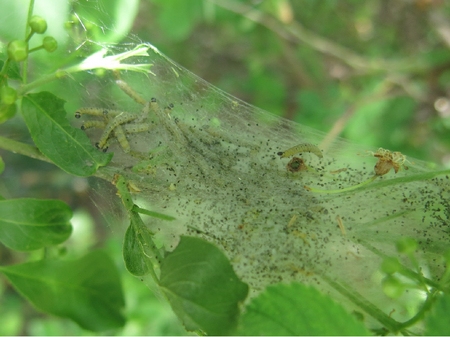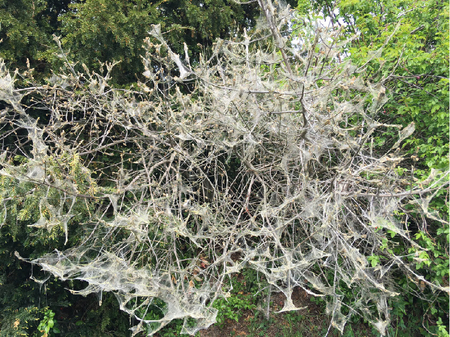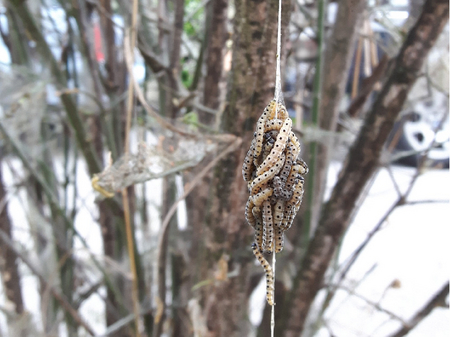Spindle ermine
Yponomeuta cagnagella
Appearance
The yellow-green caterpillars have two dark spots on each body segment and grow to about 20 mm in length.
The adults are white colored moths and measure 25 mm in wingspan, their forewings are covered with numerous small black dots.
The eggs are shield-shaped and about 0.4 mm in diameter. They are laid in groups. Thereby the eggs overlap like roof tiles.
Biology
The spider moth belongs to the family of moths called Yponomeutidae. The gypsy moths are a group of small butterflies, which all look extremely similar. They differ only in the host plants they attack: for example, each has its own species on spindle tree, blackthorn, weeping cherry or apple trees.
Spider moths overwinter in the egg stage. Individual eggs are laid in groups on smaller twigs. In March/April, small caterpillars hatch from them and feed around fresh shoots. In doing so, they create a common web in which they live protected from enemies. In total, the caterpillars go through five larval stages. Then they begin to spin a cocoon in which they pupate. These cocoons often lie close together in the common "webs nest". From these hatch moths in June and July, which mate. After about ten days of egg maturation, they proceed to lay their eggs for the next year.
Damage symptoms
Initially, only individual shoot tips are spidered, but with heavy infestation, entire plants appear as if enveloped in a fine net. This can also result in complete balding. Masses of caterpillars can be found in the webs.



Economic importance
The economic importance of the spider moth is negligible. It produces only one generation per year, so that the damage caused is usually limited. The host plants usually recover very well after infestation by the caterpillars and sprout again. Species that infest fruit trees (e.g. apple webworm moth) may cause yield losses.
Prevention and control
- Destroy caterpillar nests with sharp water jet
- Cut away caterpillar nests
- Encourage natural counterparts: Birds, parasites, e.g., various species of caterpillar flies, etc.
- Use of a plant protection product: For home gardens, products based on the bacterium Bacillus thuringiensis or the natural substances azadirachtin or pyrethrum are suitable (see list of plant protection products approved in Austria).
Last updated: 17.01.2022
automatically translated